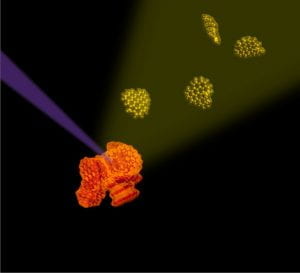A collaboration between GW Chemistry's Miller and Vertes labs has led to a recent accepted article which is available online in the journal Angewandte Chemie International Edition, a publication of the German Chemical Society.
Abstract: Soot (sometimes referred to as Black Carbon) is produced when hydrocarbon fuels are burned. Our hypothesis is that polynuclear aromatic hydrocarbon (PAH) molecules are the dominant component of soot, with individual PAH molecules forming ordered stacks that agglomerate into primary particles (PP). Here we show that the PAH composition of soot can be exactly determined and spatially resolved by low-fluence laser desorption ionization, coupled with high-resolution mass spectrometry imaging. This analysis revealed that PAHs of 239-838 Da, containing few oxygenated species, comprise the soot observed in an ethylene diffusion flame. As informed by chemical graph theory (CGT), the vast majority of species observed in the sampled particulate matter may be described as benzenoids, consisting of only fused 6-membered rings. Within that limit, there is clear evidence for the presence of radical PAH in the particulate samples. Further, for benzenoid structures the observed empirical formulae limit the observed isomers to those which are nearly circular with high aromatic conjugation lengths for a given aromatic ring count. These results stand in contrast to recent reports that suggest higher aliphatic composition of primary particles

